Updated Summer 2025
In England wild camping it is illegal. But also lots of fun if you do it sensibly and respectfully! There’s nothing quite like a spot of wild camping in the Lake District for a real and rewarding wilderness experience, especially if you’ve hiked hard all day to find that perfect spot. There are lots of wild camping sites in the Lake District, all with something unique to offer, you just need to find them.
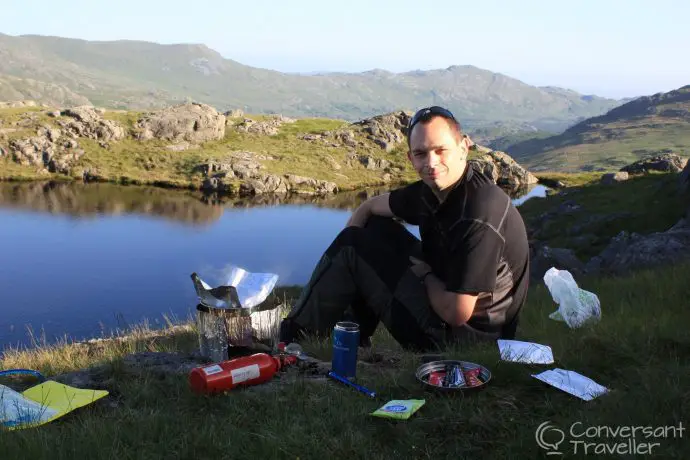
How to go Wild Camping in the Lake District
If you’re wondering where to go wild camping in the Lake District, then we’re to help. Although we can’t reveal the exact locations where we’ve camped (as per the ‘code’ amongst wild campers to ensure their favourite places don’t become a circus) we can tell you how to go about it yourself, and find your very own secret pitches.
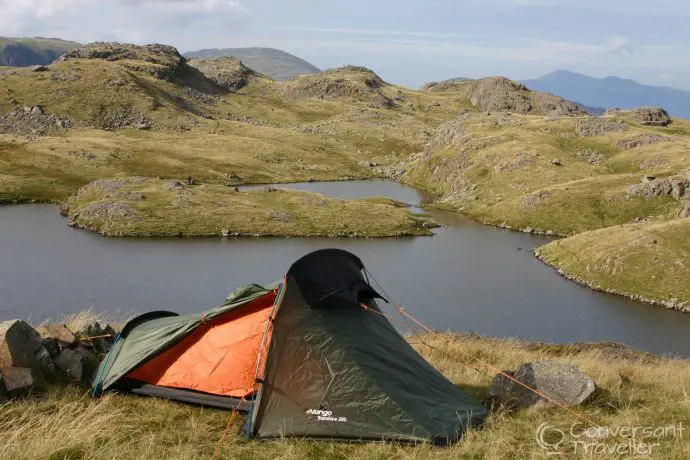
The State of Lake District Wild Camping in 2025
Although wild camping in the Lake District is illegal, it’s historically been tolerated as most campers are respectful, follow the rules, and leave no trace.
However, in recent years that has changed, with visitors flocking up to the Lake District in search of easy adventure, without any regard to the local landscape or other people. These imbeciles pitch their throw-away festival-style tents right on the lake shores, think it’s okay to light fires and have barbecues on the grass, and leave their litter (and sometimes human mess too!) strewn around the site after they leave. Many of these ignorant idiots even leave their tents, too lazy to clear up after their fun. There are no words – this is not the way to do it. As locals, we feel pushed out of the park during summer as the laybys are full and any accessible scenic spots are crammed with people settling in with their beers, music and tents.
To try to combat this antisocial behaviour, a Public Spaces Protection Order has been put in place and fixed penalty notices are now being issued. We hope this will help, but think it’s going to be a long road ahead.
Wild Camping Rules
For courteous and responsible wild camping, please follow these guidelines:
1) Seek permission from the landowner. In reality this isn’t always practical or really necessary if high up in the Lakeland fells. In which case:
2) Pitch away from roads, and well into the mountains – you should be above the highest fence or dry stone wall.
3) Keep groups small, never more than 2 small tents.
4) Camp unobtrusively out of sight of footpaths, and try to blend in with your surroundings – a green tent is much better than an orange one!
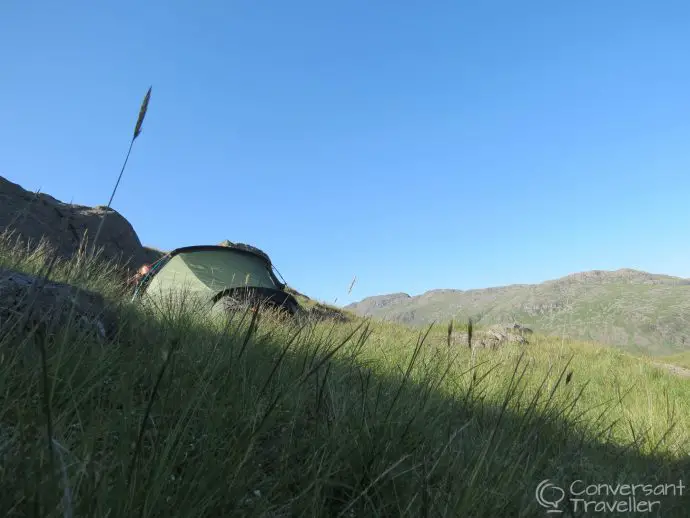
5) Always find a spot at least 30 metres from running/fresh water when going to the toilet. Dig a small hole to bury excrement.
6) Avoid fires as these can damage the ground and vegetation – use a stove instead.
7) Move on and don’t stay in the same place more than one night – this allows the ground to recover and keeps wildlife disturbance to a minimum.
8) Leave nothing behind, and do not bury litter.
9) And above all, have fun!
You can check out the National Trust’s handy wild camping rules too.
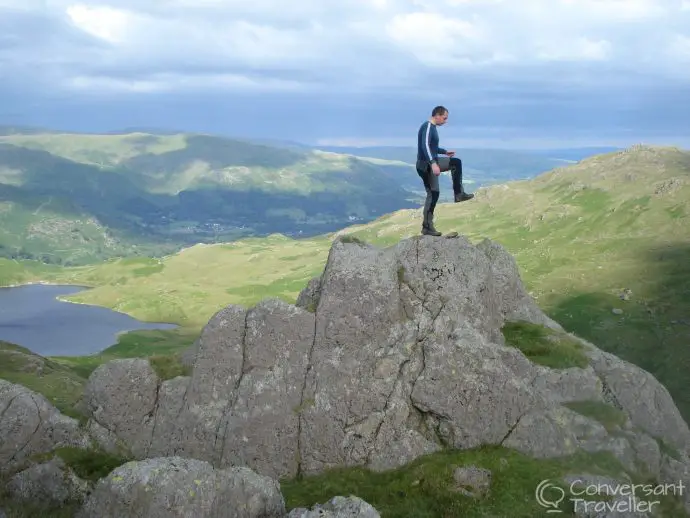
Top Tips for Wild Camping in the Lake District
Location
You don’t need to walk for miles to find a suitable spot for wild camping in the Lake District, often there are gems just hidden a mere 20 minutes from the higher roads, if you know where to look.
To make it easier, get an OS map for the Lake District and pick a spot with a tarn – make sure its a small one (almost a speck on the map) otherwise you may have company, especially during the summer. It may be boggy directly by the tarn, but you should be able to find a spot not too far away with great views, as well as a source of running water (don’t drink from the tarn itself, use a stream, and boil all water before consuming). Other great spots are near plunge pools – look for waterfalls on the OS map, and also check out the satellite images on Google maps – this is how we find a lot of our spots!
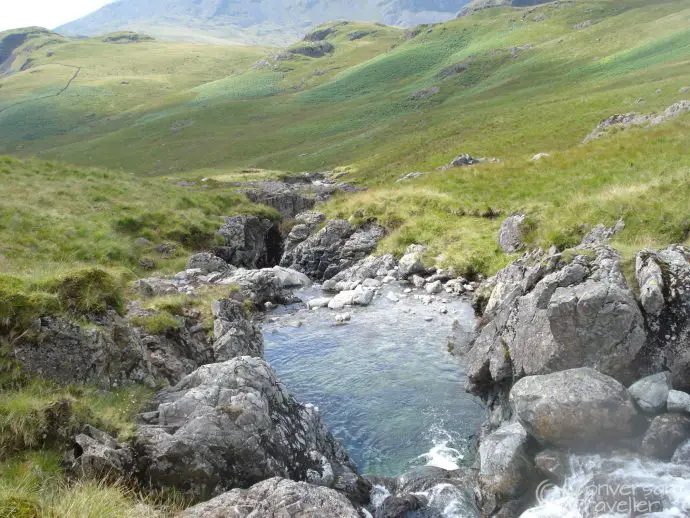
Read More: Glamping in the Severn Vale – as seen on George Clarke’s Amazing Spaces
Arrival and Departure Time
Set off in the early evening…soon enough to be able to enjoy the site when you get there, but late enough not to attract attention during the day. You should leave early the next morning (you’ll be awake anyway!)…we’re often back home before breakfast time ready for a full English to top off the experience.
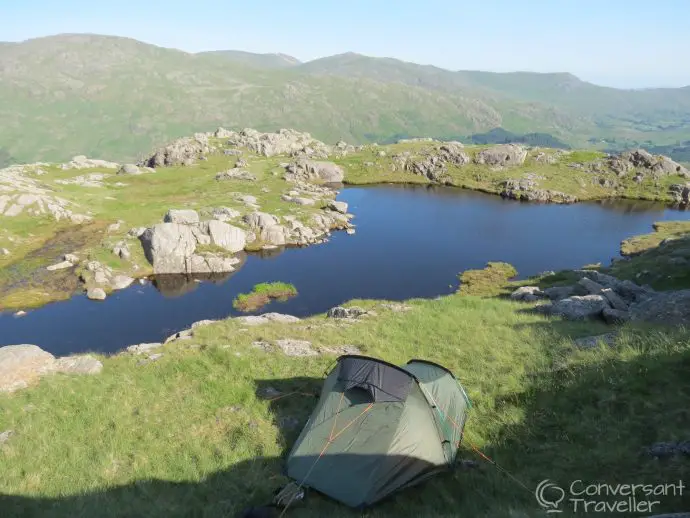
The Wild Camping Shop – What Gear to Take
Wild camping in the Lake District isn’t about hardship or survival. It’s about having fun too. So it’s worth investing in the following to make your life a little easier (and more comfortable!):
Wild Guide Lake District and Yorkshire Dales – we love these books, packed with insider tips of secret places to discover, and lots of inspiration for camping and wild swimming.
Essential Wild Camping Gear – the Basics
Rucksack – between 35 and 60 litres, depending on how much kit you want to lug up the mountain, and how many nights you intend to camp out. We use 35 litre sacks for one night trips with lightweight kit. Make sure you purchase a decent quality rucksack that can withstand a bit of weather and rough handling. You don’t want your kit getting wet!
Rucksack liner – these weigh very little but are worth every extra gram, as there’s nothing worse than pitching your tent after a long hike in the rain to discover all your kit, including clothes and sleeping bag, is wet. We suggest buying a liner slightly larger than your rucksack capacity to allow enough extra at the top to roll over properly to ensure a good seal.
Bivi tent – we love Vango and Wild Country tents, and at the moment have a Vango Banshee 200 which is literally worth its weight in gold as it’s very small and light to pack. Forget about lugging your standard campsite tent up into the fells, you will regret the extra weight with every step you take. Bivi tents don’t take up much room, but still do a good job of keeping out the weather! The Vango Banshee even has a small porch area for your boots and bags.
Thermarest – much more comfortable than foam mats, and they fit inside your rucksack thus avoiding the risk of being mistaken for Duke of Edinburgh Award initiates). We love our Thermarest Prolite Mattresses. They’re really comfy, and have a textured surface which stops them slipping all over the tent when you’re camping on a slight slope (the ground is never 100% flat!).
Lightweight Sleeping Bag– don’t leave home without one! It does get very cold up in the fells at night, even in the summer! If you plan on doing a lot of wild camping, it’s worth investing in a lightweight sleeping bag rather than hauling up the big fluffy cocoon that you’d normally use whilst camping on sites, near the car!
Shop Lightweight Sleeping Bags
Sleeping Bag Liner – having one of these makes the world of difference during those cold mountain nights, giving you another insulating layer of protection. Silk is the best material, and although a little more expensive than cotton liners, is worth every penny. We like the mummy style liners, as they fit better and more snugly inside your sleeping bag.
Hiking Boots – you’ll need a decent pair of proper walking boots for hiking up in the mountains. Trainers are not advised unless you want to twist your ankle and end up with soggy socks! We’re tried and tested fans of Merrell, Lowa and Salomon, but the important thing is to buy a pair that fits well, is waterproof and breathable (Gortex is best), and make sure you wear them in a bit before heading to the hills.
Read More: Tried and Tested – our Review of the Lowa Renegade GTX Boot
Hiking Socks – It’s so important to get these right, so you don’t end up with unnecessary blisters (they can make or break a wild camping trip!). We like the merino wool socks, as they’re great at moisture wicking, and keep your feet toasty in the winter, and cool in the summer. They’re also good act cushioning your feet in all the right places.
Compede – even the most hardy hikers sometimes get blisters, and we always carry a small pouch of compede, which acts as a second skin for pressure points on your foot. The trick is to catch them early, before the blister actually forms.
Travel First Aid Kit – just in case! It’s always a good idea to have a few emergency items at hand, after all, help may be a long way away depending on how far you’ve walked.
Head Torch – you can’t go wild camping without one of these. They’re lightweight, hands free and important for those middle of the night wees or pitching the tent if you arrive a bit later than expected!
Stove – you should always use a stove rather than lighting a fire when wild camping in the Lake District. It’s more reliable anyway, as you don’t need to battle with wet wood! We have an MSR WhisperLite International, and it’s been all over the world with us! It’s very efficient and quick to boil, and you just can’t beat the satisfying sound of the flames roaring whilst waiting for dinner. Another good option is the Jetboil Stove, which is really lightweight, and easy to use for first time campers.
Shop Lightweight Camping Stoves
Thermal Mug – perfect for keeping your hot drinks warm, thawing out cold hands, or even soup!
LifeStraw personal water filter – these are perfect for travelling as well as wild camping as they remove 99% of bacteria, including e-coli, salmonella, and waterborne protozoa including Giardia.
Pocket Knife – always handy, whether you’re half way up a mountain or in your own back yard.
Plastic plates – if you’re not keen on eating straight out of the pan (or packet!) then invest in some lightweight, packable plastic crockery, like this neat little kit from Light My Fire.
Food – When I first started wild camping in the Lake District with my Dad when I was a nipper, we’d take up tins of chunky chicken and meatballs for dinner. To be fair, he carried most of it! Today, hubbie and I go for the more lightweight option. If you have a stove (like the MSR whisperlite) that can boil a pot of water, we recommend Wayfayrers boil in the bag meals – their roots can be traced back to ration packs given to British military troops for sustenance during manoeuvres in harsh environments. The terrain in which we find ourselves is perhaps less of a challenge, but they’re still really tasty and not freeze-dried, with lots of flavours to choose from and no washing up afterwards! Personal favourites are Thai Green Curry, Lancashire Hot Pot and Beef Stew and Dumplings. The puddings aren’t quite so good (tend to be a bit on the solid, heavy-in-your stomach side) but the best of them is the sticky toffee pudding.
If you have a Jetboil stove which just boils a mug of water you’ll need freeze-dried food that can be rehydrated. Check out the Expedition Foods pouches, lots of tasty flavours to choose from! Add in some flapjack for breakfast, and a few coffee sachets (for the next morning after very little sleep) and you’re sorted.
Coffee – take several of the 2 in 1 coffee sachets for your morning cuppa. They take up hardly any space, and already come with milk!
Cameras – perhaps not essential to survival, but necessary nonetheless! As we don’t suggest lugging up your SLR (although Hubbie has been known to on occasion), we love taking our Canon GX7 as it’s small and light, as well as producing a good quality image, and can easily be shoved in a pocket.
Bug Spray – because sometimes the mozzies like your camping spot too. It’s best to take natural insect spray so you don’t harm the environment.
Essential Wild Camping Kit – Clothing
Waterproof Jacket – no Cumbrian ever leaves home without a waterproof jacket, and it’s the first thing you should pack if you’re going wild camping (just make sure it’s near the top of your rucksack so it’s handy in case the heavens open at short notice!). The most important thing is to make sure your jacket is breathable, again Gortex is great. Without a breathable jacket you’ll end up sweating and be just as wet as if you’d gone without a jacket in the first place.
Waterproof Trousers– just as important as a waterproof jacket, and gain, breathable is a must!
Thermal underwear – always take warm gear (e.g. thermals) even if its boiling hot in the middle of summer. It get’s pretty chilly at night and it’s good to have something different to sleep in. We’re fans of Helly Hansen thermals, and not just because they come in hot pink for the girls!
Little Luxuries (if you have room!)
Spork – this is a brilliant lightweight invention, and we have them in abundance at home…in our cars, in our camping box, at work…we never leave home without one, you just never know when it might come in useful! They’re perfect for eating camping food too!
Pooper-scooper – (more commonly known as a garden trowel) for digging those all important holes. Plenty of lightweight ones around. Also handy as a defence weapon against night-time intruders.
Sit mats – a godsend for your bum as a foam insulation against cold and damp ground, as well as extra insulation under your pillow at night. Good for picnics too!
Mosquito coils – because the little blighters are good at choosing great wild camping spots near tarns too! These coils are great because you just set them off burning outside your tent and the smoke keeps them away whilst you’re cooking dinner. You could take some mosquito repellent too, for still nights in the summer.
Portable LED lights – okay, this one is a LOT of a luxury, but they don’t really weigh anything and make the tent homely and great for reading by (if you’ve lugged a book up that is!). Great idea that Hubbie introduced last year to stop me moaning about always having to wear a head torch.
Paracord Safety Bracelet – a nifty little bracelet with built in paracord (handy for handing stuff out to dry!), compass, fire starter, emergency knife and whistle. Even if you never have to use any of these, it still looks cool!
Flip-flops – ok so not strictly necessary, but if you can fit these in the rucksack, your feet will thank you when they have an alternative to sweaty boots around camp after a hard day’s hike.
Pillowcase – again, a total luxury, but hardly weighs anything (particularly when Hubbie carries them) and is a godsend at night, stuffed with your clothes to make a decent head rest. You can even use it as a laundry bag the next morning.
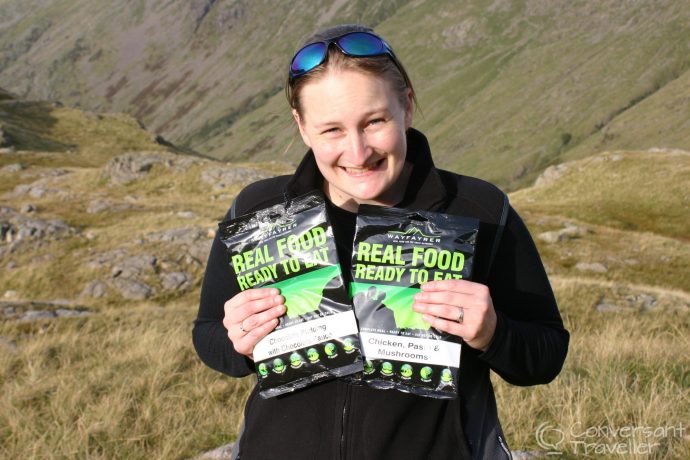
It really is a pity that wild camping hasn’t been legalised in England, but on a recent night spent up in the fells, we had a taste of what the future could hold should this change. Way down in the valley below, not more than a few metres from the road, a large group had set up camp on farmland. The tents were large, numerous and red.
Observing the activity for a few minutes we realised they’d visited the plantation across the field and helped themselves to a large pile of firewood to feed their bonfire which was becoming increasingly surrounded by empty beer cans and other litter. Muttering oaths about irresponsible louts under our breaths (not that anyone could hear us up there) we stomped back to our little green bivy tent, tucked away out of sight on our moral high ground, and consoled ourselves with getting dinner ready.
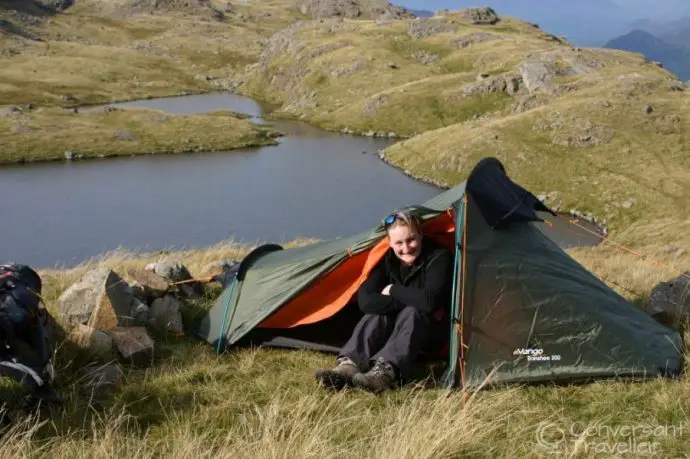
Later that evening, we were tucked up in our sleeping bags and about to drift off to a peaceful sleep (who am I kidding? We never get much sleep wild camping, something to do with there only being enough space for 1 and a half people, and the fact we always manage to pitch on a slope) when the resonating beat of a bass line came thumbing up the valley. We were so cross we were ready to march right down there and give them a few choice words, but the sticky toffee pudding from dinner (yeah we like our luxuries, even when camping!) was still sitting lodged in our bellies and the thought of having to then climb all the way back up again made us reassess.
So, perhaps it is a good thing that wild camping in the Lake District is illegal, or the hills would be alive with the sound of, erm….’music’??
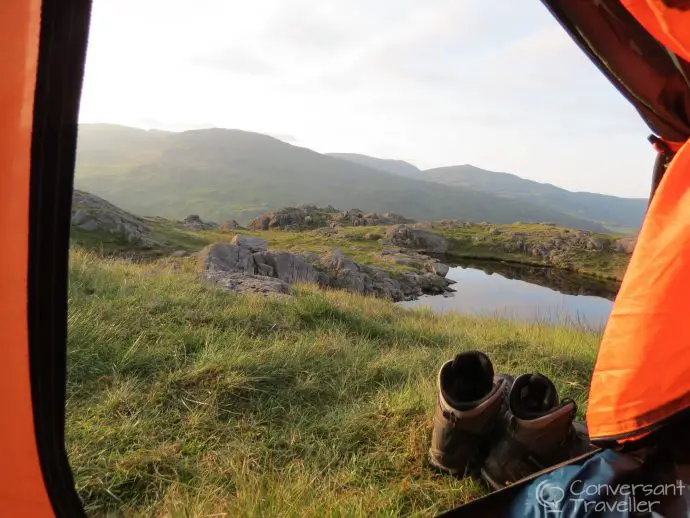
Finally, one last tip would be to book yourself into a nice warm, comfy Lake District hotel for after your wild camping adventure. It sure is fun out there in the hills, but you won’t have the best night’s sleep, so why not reward yourself for all your efforts!
Please don’t ask me for advice on WHERE to camp.
I won’t tell you. It’s nothing personal, just all part of the wild camping code. I don’t want to find dozens of other campers at my favourite spots next time I’m up there, and I’m sure you wouldn’t appreciate the company either. Besides, it’s half the fun choosing your own special place to pitch.
I receive dozens of emails each week asking me to spill the beans. Whilst I’m happy to give general advice I won’t be revealing locations. Sorry.
Go out and explore, abide by the rules, and above all…HAVE FUN!
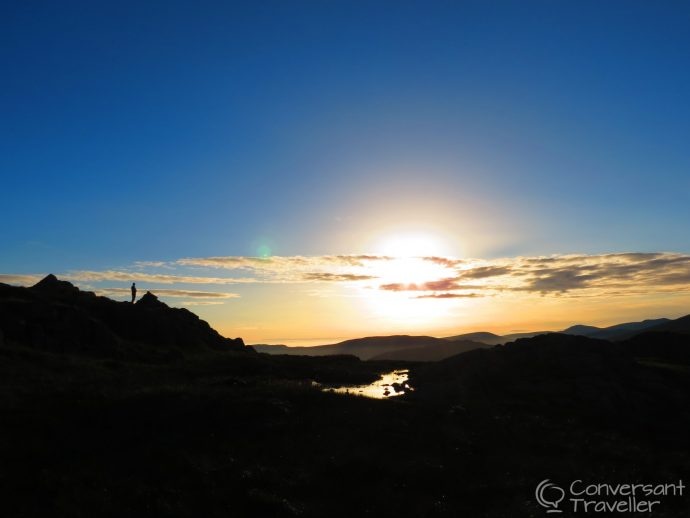
Have you been wild camping before? I’d love to hear about your experience!
Read More: camping out in a disused church – and how you can too!

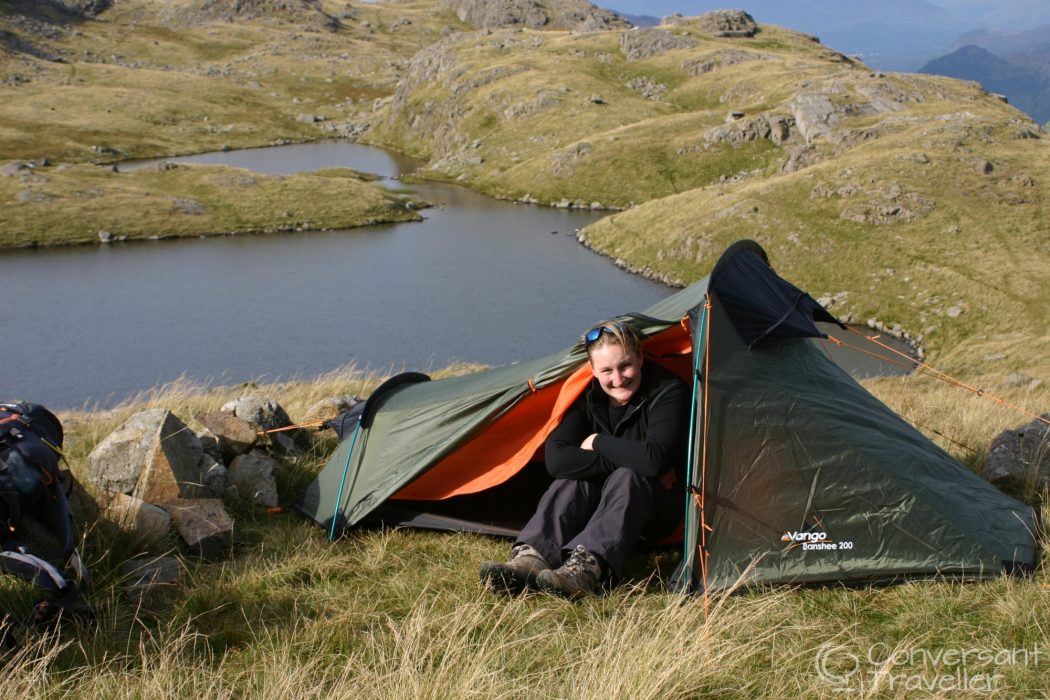
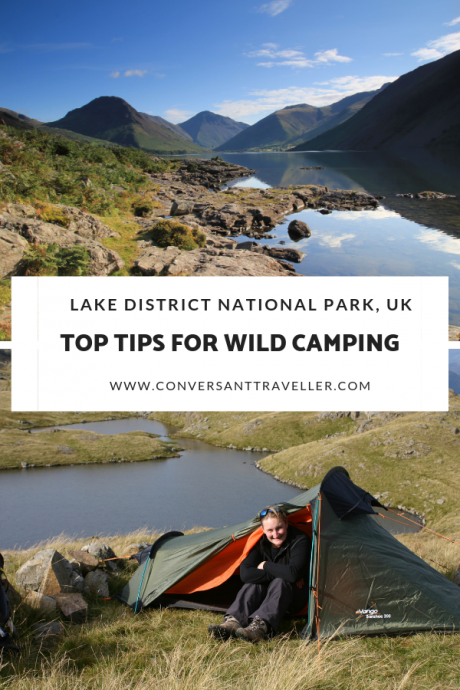

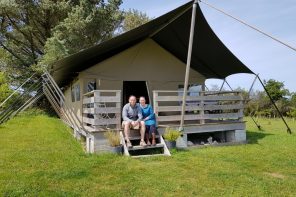


I’m taking my son wild camping for the first time in August, and wanted to say thankyou. I found this blog informative and very enjoyable. We are going to walk Fleetwith pike, Haystacks, High Crag and red pike at Buttermere. Only camping the 1 night with it being his first time. Hopefully he gets the bug (not the midgies):-)! The tips and photos on here are amazing. Thanks again.
Hi Daniel, thanks for your lovely comment, and so glad you found the post useful. I’m sure you’ll both have a great time (you’ve chosen some fab peaks to conquer). 1 night is always best for a first time, so hope your son decides he loves it – though better take some bug spray just in case, and don’t camp too near any water since that’s where the little blighters love to hang out 😉 We’d love to know how it goes, so do let us know! Happy camping…
Wow, what a fantastic view! It looks so wild and beautiful, I wish someday I`ll have the chance to camp near the Lake District. And thanks for sharing so much helpful information with us, like the list of camping gear!
Hi, I’m 66 and have 2 children, 11 and 13, but i still take them wild camping each year, a good thin air mat, worth it’s weight in gold to get a good nights sleep up on the mountain tops. When the kids were first going they said no, not up the mountains. But nowadays it when are we going again
Hi John, thanks for your comment, it’s great to hear you’re still all going out to wild camp, and totally agree a thermorest/air mat makes the world of difference when it comes to getting some zzzzz’s. Hope your children continue to enjoy it too!
Hi Heather,
I’ve booked to come to the Lakes for a couple of days in late feb/early march.
Reasonable to consider wild camping? Or better to stick with day hikes and a cosy airbnb?
Thanks!
Paul
On the plus side you’ll probably have the camping spots to yourself. On the other hand it will be cold, especially higher up! If you’re tough, up for an adventure and have kit decent enough to cope with the temperature (i.e. a winter sleeping bag) then you could have a great time. We would have done it in our ‘younger’ days, but now personally I’m a bit of a fair weather camper and would take the airbnb in Feb! 😉 Whatever you decide, have a great time!
Hi, love this article. This might be a really stupid question, but how do you go about seeking permission from the land owner, and are they likely to refuse?
In reality, this really doesn’t happen, unless you’re camping low down in the valleys on what is obviously farmland. Just camp up high in the fells, away from paths and be discrete and no-one will mind (or even notice!).
Great article!
I just wanted to clarify it IS LEGAL to wild camp in England, there are just best practices and code of conducts to stick to.
General rule is camp above 450m away from main paths and bridleways and ask landowners permission
It’s legal on much of Dartmoor, but not elsewhere in England (though it is in Scotland). Of course if you have the landowners permission then it’s legal 🙂
Hi Heather.
I have just been searching on the internet for places to wild camp. And came across your blog (question and answers.)They were very helpful.
Me and my Son who is only 10 have done some traditional camping with little recourses and want to try do some wild camping.
I noticed you was going to suggest a few places to get started to Emilie , and I would be greatfull if you would give me the same advise too.
Also would you please forward some of the alternative ideas about the woodland camping areas that you was going to send to Jordan.
It’s great to find your blog thank you very much. Ps I have tried the wayfarer food it’s not that bad is it?
Hi Tony, I’ve sent you an email. We no longer divulge specific camping locations as we receive so many such requests, but hope you will be able to find some secret locations of your own by following the above advice. Happy camping!
What is it like up there around the end of December? my son (20) wants me to take him for a few nights on The Lakes. chances are it’s going to be extremely cold and probably covered in snow but he is going to Canada for 2 years middle of next year so ‘thinks’ it will be good as a taster for him. Any advice would be good.
Winter is actually one our favourite times of year up here. It can be so beautiful, and uncrowded, but of course very cold. Sometimes we get a lot of snow, sometimes we don’t, but if you’re thinking of camping in December, you’re braver than us! It will be freezing up in the hills. It’s already -4 degrees at the moment (and that’s in the morning down in the valley). Why not come but stay in a B&B instead. Weather wise, we get a lot less rain in the winter than we do in the summer (!), so chances are you’ll still be able to get out into the fells for some hiking. And if it does snow, the main routes are all kept open so still plenty of adventures to be had!
Hi Heather,
this is a great blog I love camping but up to now its all been pretty official, so I’m looking to venture into wild camping and the lake district seems the best place to start after scrolling through many different sites on the internet I’ve noticed there are a few common laws which is fine but a main one I’ve seen is that you need the land owners permission is this essential if so how do I get it? if you could help out that’d be great.
Hi Georgie, thanks for stopping by, and I’m glad you’re giving wild camping a go, I’m sure you’ll love it. Getting the land owners permission is the courteous thing to do, but in practise not always easy. It’s probably more relevant if you’re wanting to camp lower down, and can actually identify who owns the land (e.g. the nearest farm etc). And then of course the land might be owned by e.g. the National Trust, which you could find out by googling them (but they’d probably say no anyway!). But really, you want to be camping high up, out of the way, and in this case no-one really bothers asking permission. You’ll only really have problems if you camp near to dwellings or lower down in the valleys. So just aim high and you’ll be fine.
Hi Heather,
I did my first couple of wild camps not so long ago & was surfing the internet for inspiration for my next camp when I came across your wild camping blog. some great advice & nice photos. The photo of you sitting in the tent, if you look on the other side of the tarn, just above your head, thats where I pitched my tent! 8 other tents were pitched around the tarn that night, but all was quiet & a great night camping & photographing was had. Thanks & enjoy more camping!
Hi David, thanks for the lovely comment, so glad you had fun, hope you’ve caught the wild camping ‘bug’ and enjoy lots more adventures in the future. That tarn has lots of brilliant spots, and never feels crowded (plus some great views back to a certain mountain where you were pitched!).
hi, looking to go wild camping next month with some friends.. would you be able to provide the postcode of the place you stayed? would be much appreciated, thanks. shahil
We’ve stayed in dozens of places. If you drop me an email at [email protected] with more details of your trip I might be able to help.
so beautiful photos ! I go to the lake district next week, I can’t wait! do you have some advice on wild camping location, reading your blog inspired me 🙂 thanks a lot
Thanks Emilie! It’s lovely up here at the moment so hopefully you’ll have good weather. Drop me an email at [email protected] and I’ll be happy to suggest a couple of spots.
Hi, I’m wild camping in the lakes in July, was looking to stay in a heavily wooded area, any suggestion of where to go. Oh I’m staying in Braithwaite for the week so don’t want to drive more than an hour to a location to park and walk to our camp site from.
Thanks, could you please write to me with suggestions to [email protected]
thanks again…
Hi Jordan, if you’re wild camping you should always pitch high up above the highest drystone wall, which means unfortunately you won’t find any heavily wooded areas to camp in. If that’s really what you want, your best bet is to contact a land owner and ask permission to camp in their woods. I will email you a few alternative ideas too!
Hi Heather, We are off to lakes in September. My boyfriend is determined for us to wild camp under a tarp/basha set up for a night or two along the way. Im thinking this will require trees…? Do you get many things to set up a basha above highest stone wall? Thanks!
Hi Dee, that sounds very intrepid! Hope you’ve got warm (and waterproof!) sleeping bags 🙂 Not much in the way of trees that high up, although you could use a wall (just be careful not to damage it or knock any of the stones off!). You could use big boulders if you pick the right places. The Lakes are beautiful in Sept as the leaves begin to turn, but just keep an eye on the forecast, you don’t want to get caught out up there with just a basha!
Really interesting article, I’m trying to plan some wild camping in the lake district but don’t know where to start, maybe just park up and go explore!
The best thing to do is look at a map and plan ahead so you make sure you find a decent spot. Feel free to drop me an email and I could suggest a few spots great for some first time wild camping! [email protected]
That’s a GREAT campground. I can see how you obviously enjoyed that spot. Wild camping is illegal in Slovenia too, but there are lots of place to get away with it. I don’t think I’ll be sharing them on a blog though. 🙂
I bet your views are even better in Slovenia! If ever we’re over there I’ll gladly trade some first class camp pitch secrets with you 🙂 Definitely keeping the exact co-ordinates off the blog though!!
Great post! We love camping and unfortunately in The Netherlands it’s not allowed to wild camp plus it’s super crowded so you will most likely get noticed, fined and sent away. However the Lake District may be a good spot for some wild camping practise. The last time we did that was in Rocky Mountain NP in Colorado where we had to consider bears … quite a fun but a little scary thing…
Ooh, I’d love to wild camp in the Rockies, even with the bears! We experienced them in Yosemite and it was scary, but all adds to the adventure. Hope you get to try it in the Lakes one day!
Great tips and awesome camping photos! I went to the Lake district once years back, but I would love to go back and do some camping like you suggest. Happy camping!
Thanks! It’s the best way to experience the Lakes, hope you come back soon 🙂